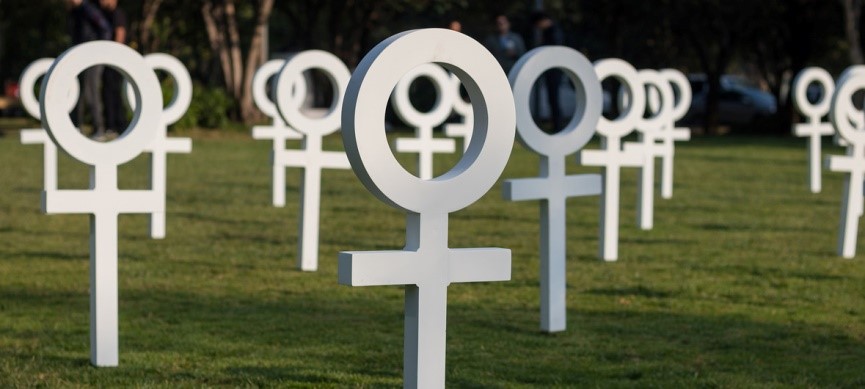Hotline: +381 61 63 84 071
Trafficking and Femicide: ultimate forms of violence against women

Trafficking and Femicide: ultimate forms of violence against women
Lately, NGO Atina has been increasingly asked about the connection between femicide and trafficking. However, before the issue was raised at a conference organized in order to mark Women Violence Victims’ National Remembrance Day in May 2019, this very connection wasn’t considered as a specific topic in Serbia.
Usually, whenever the issue of femicide was discussed, trafficking in human beings was mentioned only as a criminal circumstance in which femicide could occur, but without any further clarification of the possible deeper connection between the two. It was during this above mentioned event that a deeper connection was reveled and explained. In this regard, Atina's representative Sanja Kandic for the first time spoke particularly about the high risk of femicide for women who ended up as victims of human trafficking, as well as the victims of human trafficking who were murdered in the situation of human trafficking just because they were women. Also, women who died of the consequences of horrific events that occurred to them during the situation of human trafficking were specifically emphasized.
On the other hand, the correlation between femicide and human trafficking was explicitly mentioned in the 2018 report (of UNODC) on gender-related killing of women and girls since this report recognizes murders in the context of trafficking as an extreme form of violent killings of women. It is stated in the report that “extreme violent killings of women take place in the context of phenomena such as organized crime, drug dealing, gangs, massive migration and human and drug trafficking chains. Trafficking in persons affects more women than men, the former being predominately trafficked for sexual exploitation. Killings related to victims of human trafficking are therefore likely to affect women and involve a gender-related motive.” In short, the report pointed out that human trafficking brings one additional risk to female victims – the risk of femicide. Nonetheless, despite the recognition, it is known that in many countries worldwide femicide is still not considered a form of crime different than homicide, thus many are still unfamiliar with the notion.
Women who have been trafficked and/or exploited in prostitution are at higher risk of femicide, even though femicide of trafficked women usually remains invisible, because the victims are often untraceable. And yet, female victims of sexual and labor trafficking are particularly at risk of male violence. We must not forget that 93% of all sex trafficking victims in Europe are women and women in prostitution.
NGO Atina underlines that there are three key actions in order to combat femicide:
1) Stop the impunity! Killers are to be held responsible. Domestic abusers, traffickers, pimps, rapists: all these perpetrators have to be taken seriously by authorities and their crimes must be recognized as misogynistic, a reflection of the hate toward women in society. Every time a perpetrator of violence against women remains unpunished, justice is not served and potential perpetrators are inspired to act, because they know that the risk of appropriate punishment is low.
2) Recognize femicide for what it is! Femicide is a fatal human rights violation. It is not a private affair or the result of a few “troubled” men: it is the product of patriarchal societies that hurt women and limit their options, their power and their agency, while at the same time excusing male violence. It is a hate crime against women and it must always be recognized as such, whether we are talking about a wife killed by her husband, a trafficked woman murdered by a sex buyer, or an infanticide of a baby girl due to her sex.
3) Challenge society’s views on violence against women! As femicide is not an isolated phenomenon, but rather a global and persistent one, we must challenge the prejudices that allow it to happen. Professionals must be trained to appropriately tackle violence against women, assist the victims and prosecute the perpetrators, while society at large must be educated on the prevalence of violence against women and its root causes (no victim blaming!). Women and girls must feel comfortable in reporting violence and be offered effective support to avoid being entrapped by perpetrators.
Being the ultimate form of violence against women, femicide is a consequence of an oppressive patriarchal social environment and of a system which failed to protect women victims.
According to the United Nations Office on Drugs and Crime (UNODC), 137 women are killed every day on average by a current or ex-intimate partner or a family member. Of the 87,000 reported murders of women and girls in 2017, more than half were killed by a family member or an intimate partner. These figures led the UNODC to conclude that “home is the most dangerous place for women”. Although women only make up 20% of murder victims worldwide in total, they are killed by the people closest to them, which suggests a much more profound and continuous pattern of abuse.
The trends in femicide vary from region to region, but it is a persistent global problem. Countries of Central and Latin America, for example, have more laws recognizing femicide as specific or aggravated form of homicide (mainly due to the work of feminists over the last few years), yet the scale of the problem in the region, the negligence of law enforcement and the impunity enjoyed by perpetrators still represent obstacles to a proper implementation of the laws.
In Serbia, 26 women were victims of femicide in 2017 alone. Over the last decade, more than 300 women were murdered, leaving over 400 orphan children. However, it is important to note that most of these femicide numbers are related to victims of intimate partner violence (usually referred to as domestic violence) and do not necessarily include other forms of femicide cited in the Vienna Declaration. In fact, only few countries report the deaths of women in regard to other circumstances besides intimate partner violence as femicide. Trafficked women, for example, are notoriously left out of these statistics.
Femicide is a murder of a woman or a girl just because she is female. It is a sex-based hate crime and it can happen in the context of various forms of violence against women. According to the Vienna Declaration on Femicide, its broad definition includes: “(1) the murder of women as a result of intimate partner violence; (2) the torture and misogynist slaying of women; (3) killing of women and girls in the name of ‘honor’; (4) targeted killing of women and girls in the context of armed conflict; (5) dowry- related killings of women; (6) killing of women and girls because of their sexual orientation and gender identity; (7) the killing of aboriginal and indigenous women and girls because of their gender; (8) female infanticide and gender-based sex selection foeticide; (9) genital mutilation related deaths; (10) accusations of witchcraft; and (11) other femicides connected with gangs, organized crime, drug dealers, human trafficking and the proliferation of small arms.”












 FACEBOOK
FACEBOOK TWITTER
TWITTER YOUTUBE
YOUTUBE